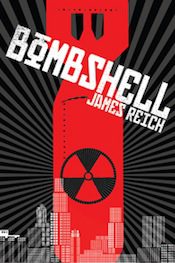
Bombshell, James Reich’s second novel, is an incredibly dense, rich, and well-paced novel. Within its 259 pages the reader encounters Chernobyl, feminism, terrorism, rendition, Valerie Solanas, Jane Fonda, Hiroshima, the Trinity test site, and much more. In the hands of another novelist, this sheer mass of information and references might result in a novel bloated with digressions. Luckily, Reich’s punchy, no bullshit prose style and love of action keeps the plot moving swiftly ever forward toward a seemingly inevitable, doom-filled climax that has much to say about nuclear power without ever feeling pedantic.
From New Mexico to New York, Bombshell follows Varyushka Cash on a cross-country spree of terror targeting America’s sprawling map of nuclear industry. Born in Russia’s atomic city of Pripyat at the exact moment of Chernobyl’s destructive meltdown, Cash carries with her the birth memories of the Chernobyl tragedy, as well as hazy memories of the parents who smuggled her into America and then disappeared. Though technically a “survivor” of the accident, as she nears her 25th birthday in 2011, Cash knows her body is failing from the exposure to radiation years before. As her inevitable death nears, and under the influence of Solanas’s SCUM Manifesto and her own research on America’s nuclear past and present, Cash’s at-all-costs mission seeks to singlehandedly take down the nuclear industry and alert the American people to their own country’s vulnerability and failing atomic infrastructure at the hands of their corporate masters. On her trail from the beginning to the bitter end is CIA rendition expert, sexual deviant, and all around psychopath, Robert Dresner. Dresner’s plans for a clean and easy rendition mission are constantly thwarted by Cash until a final showdown with Dresner in a evacuated and irradiated New York City turns the CIA mission into a personal vendetta.
If this sounds like a lot, it is. Add into this mix an eclectic group of supporting characters including Cash’s young, adopted mothers who raise her amidst the riotgrrrl movement of the Pacific Northwest in the 90s, and Molly Pinkerton (post-op transsexual, Vietnam veteran, and Cash’s only real friend in New Mexico), and you have the definite possibility of information overload and confusion. Yet, by deftly and quickly developing each of his characters, and never subordinating plot to characterization, Reich is able to keep the story moving forward, each new character serving as a clue to Cash’s past and personality, instead of just empty cardboard cutouts or local color. Take for example Reich’s description of Nona Laveau, young woman who surprisingly receives Cash as a baby from her fleeing parents, and Cash’s first surrogate mother:
Nona was the eldest at twenty-five. Nona told Cash about women with strange names: Sojourner Truth, bell hooks; and she introduced Cash to Wonder Woman comic strips on yellowing paper… They danced together in the disintegrating living room, kicking clots out of the carpet… “Cash, do you remember how I told you that Wonder Woman is from a tribe of powerful women called the Amazons? Her priority is truth. That’s what she cares about, exposing things to the light.”
Each character that Reich brings in to the narrative is used to reflect on his protagonist in some useful and defining way. And while each character is carefully described and differentiated physically and visually, the bulk of the characterization importantly comes from their actions and speech, making them feel like real people rather than just mouthpieces for the narrator or author. Using the characters in this way also helps Reich avoid having to spend long periods of on exposition, instead letting the characters shed light onto Cash, rather than Reich himself, and privileging the relationships between characters, again making them feel more complete.

This complex characterization also proves at times more uncomfortable for the reader than the graphic violence sprinkled throughout. As Reich constantly upends the typical roles of terrorist and terrorist hunter, the reader feels more and more sympathetic towards Cash, even as the body count rises and she gets closer and closer to her ultimate goal of releasing a nuclear disaster upon America. The novel, drafted before and published in the wake of the Fukushima disaster in Japan, seems to key in to a recent upswing in unease about nuclear power, and the myths about nuclear power being clean. Under the guise of Cash’s research into America’s nuclear plants, Reich is able to further tap into this unease by seamlessly working in little known historical instances of failures on the part of our country’s nuclear industry, no doubt quickly covered up by this same industry. By characterizing Cash not simply as a crazed terrorist or assassin, but rather as a methodical and well-thought out philosopher of sorts, Reich weaves this shocking history into the narrative and makes it seem like Cash’s polemic rather than his own.
Reich also excels at manipulating time and space in the narrative so that any point in the present moment can feel simultaneously like any other. Right from the start of the novel, as Cash crawls through the desert of New Mexico to perform her first act of terrorism, the moment feels both old and new, historic and futuristic:
April 1, 2011. Varyushka Cash crossed the red wasteland in darkness, under the radar, wires, and hexes that had been cast over the contaminated ground… she watched crystals and lambent minerals glimmering in the blood-red rocks between sparse shadowy cacti… she lay on her back staring into the black sky, analyzing the silver zodiac thrown out over this other forbidden space of the world. For minutes, she was paralyzed beneath its brittle, radioactive fur. The silence was profound.
Reich’s description here of Cash’s progress through the desert toward the Trinity test site, and her first act of terrorism, is of course vivid, but also feel strangely out of time. The emptiness of the desert and immensity of the night sky seem to suggest the desert of the past, prior to human intervention. Yet the inclusion of the wire suggests a contemporary time where man’s mark and demarcation of the world are in full effect. The “red wasteland,” “the contaminated ground,” “the blood-red rocks” push the reader forward in time to imagine a future of apocalypse. Thus, Cash, and the reader, seem to be in three separate times at once. Furthermore, Cash’s single-mindedness of purpose, and constant birth memories of Pripyat and the Chernobyl meltdown also intrude upon whatever place she is in. At any given moment, the “forbidden space” of Chernobyl can lay itself over whatever place Cash is in, as is seen above, or when new-New York City becomes Chernobyl by the end of the book. Rather than causing confusion, this masterful strategy of Reich’s brings the reader even deeper inside Cash’s psyche, and suggests a circularity or interconnectedness to the world and its past, present, and future selves.
James Reich’s new novel stands out because, for all the loudness of its characters and subject matter, it manages to feel subtle and seamless in its execution. It’s a novel that doesn’t sacrifice politics for plot, or vice versa, and it’s a novel that will pass by too quickly and leave you wondering what in the world its author will dream up next.




